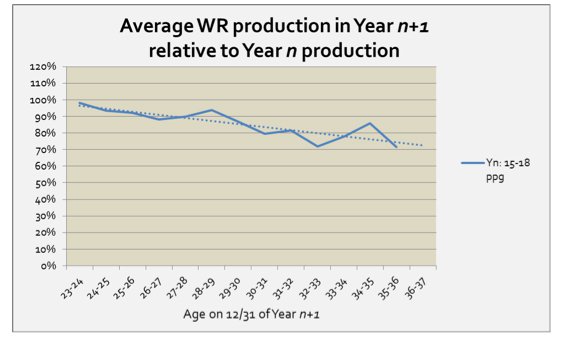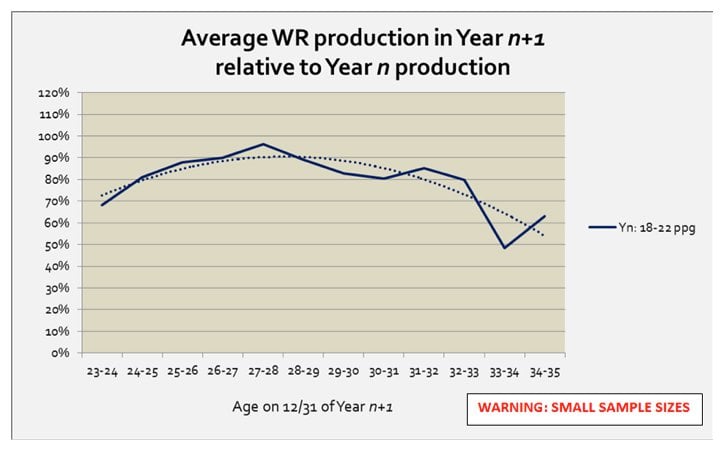Real Degens Have Curves

We all know how wide receivers age – they improve in their early twenties, peak around age 26 or 27 and gently decline into their thirties. This pattern has been documented by respected sources, and I have no reason to question its accuracy. However, it doesn’t tell the whole story, especially for dynasty owners.
The typical age production curve paints a picture of all NFL receivers’ aggregate production at a given age. That method is helpful for long-term player valuation, but it doesn’t tell us much about what to expect from any individual player. My goal is to create a reasonably accurate system for predicting a player’s future performance using only objective measures – age, past performance, body measurements, etc. This article represents a small step toward that goal.
I compiled the age and PPR fantasy points per game (ppg) for every wide receiver season of at least three ppg from 2004 to 2014. I then made buckets for seasons of 12-15 ppg, 15-18 ppg and 18-22 ppg and calculated the average ppg for each of those buckets. Finally, I calculated a ratio of performance in Year n+1 to performance in Year n and charted the results.
Below are the results, beginning with the 12-15 ppg and 15-18 ppg buckets.
[am4show have=’g1;’ guest_error=’sub_message’ user_error=’sub_message’ ]


These charts are quite similar to each other, but look quite different from the classic age-production curves we’re used to seeing.
Here’s what they mean.
Age 23 and 24 wide receivers coming off a 12-15 ppg or 15-18 ppg season scored, on average, about the same as they had scored in the previous season. Obviously, some scored far more and others scored far less, but as a whole they matched their prior season’s production. As receivers aged, their average production following a 12-15 ppg or 15-18 ppg season declined fairly steadily. By age 30, receivers who scored 12-15 ppg the prior year average only about 90% of that production the next year, and receivers who scored 15-18 ppg the prior year averaged only about 85% of that the next year. By age 35 and 36, receivers as a whole are averaging less than 75% of their previous season’s production – a massive drop.
These charts suggest professional receivers’ “breakout age” matters – a 12-15 ppg or 15-18 ppg season at age 22 is better news than the same season at age 24. In the last year or so, Shawn Siegele and others thrust breakout age into mainstream NFL draft discussion, arguing college breakout age is an important predictor of NFL success. Not surprisingly (but also not obviously), professional breakout age also appears to be a useful predictor.
Now if you’re a fan of calculus (and really, who isn’t?), you may notice a relationship with the charts above and the classic age curves. Namely, the curves above look like they could chart the derivatives of the classic age curves. That’s because the above curves represent the rates of change of player’s age-production curves as they pass through particular scoring ranges.
Translation: Receivers don’t peak in their early 20s, but that’s their peak in terms of reproducing (or exceeding) their previous season’s production. As for older receivers, not only do they face a yearly risk of losing production, that risk appears to increase each season. This should concern anyone holding onto Roddy White or Larry Fitzgerald. We already knew their careers were likely all downhill from here. The charts above suggest the hill will get steeper every year. (Andre Johnson fits this age/production group too, of course, but he’s tougher to predict, given his dramatic change in circumstances.)
When we turn to the 18-22 ppg bucket, the curve looks notably different, especially for the younger receivers.

First, please note the warning. There are only three age 23-24 receivers, one age 33-34 receiver, and two age 34-35 receivers in this bucket. With samples that small (and overlapping, no less), we’re not doing statistics – we’re just guessing with numbers.
That said, the patterns suggested by this curve are intuitive and interesting. The striking difference between this curve and the others is the relatively poor showing by young receivers. Part of this is almost certainly sample size. After all, this chart suggests that age 23-24 receivers returning from an 18-22 ppg season will average a lower ppg the than same-aged receivers returning from a 15-18 ppg season. We could tell a story of why that’s so, but it wouldn’t be a very convincing one.
Still, it’s reasonable to think age 23 receivers in this bucket are more likely to fall off than age 27 ones. An age 23 receiver in this bucket is almost certainly coming off his breakout season, while an age 27 receiver is likely to be a fully formed stud – this is why drafters are more comfortable with Julio Jones than Odell Beckham as a redraft pick. (Note, however, that Beckham wouldn’t qualify for this bucket because his age 22 season was too productive.) And unlike in the other buckets, there’s very little upside to offset the risk of a young receiver falling back to the pack.
Once the 18-22 ppg curve hits its peak, it looks pretty similar to the others. The rare stud heading into his age 32 or 33 season after putting up 18-22 ppg the previous year is likely headed for a substantial drop.
So, what should we make of all this? Here are the most important takeaways:
- Professional breakout age matters. A receiver who puts up 12-18 ppg at age 22 projects better the following year than a receiver with the same production at age 24.
- Not only do older receivers face an annual risk of decline, the rate of expected decline increases each year.
- The sample sizes are small, but receivers who produce elite numbers (18-22 ppg) in their early 20s appear riskier than those who produce the same numbers in their mid-20s. There’s some evidence supporting those who worry about Beckham not producing like a top receiver in 2015.
[/am4show]
- Dynasty Capsule: Miami Dolphins - January 26, 2019
- Dynasty Capsule: Buffalo Bills - January 21, 2019
- Dynasty Capsule: Carolina Panthers - January 21, 2018

































































